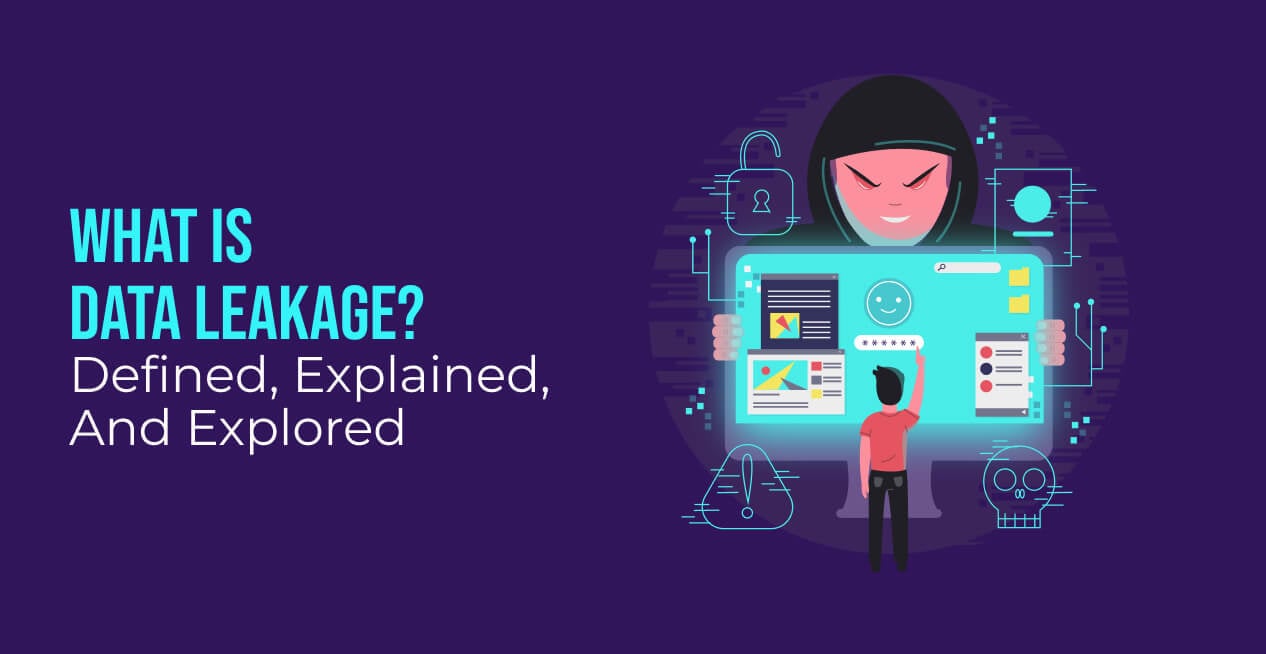-
Introduction
-
What is Data Leakage?
- Why Is Data Leakage Prevention Important?
- Types of Data Leakage
-
Recent data leakage examples 2023
-
What's the Difference Between a Data Leak and a Data Breach?
- Most common causes of data leaks
- How to Prevent Data Leaks?
-
What types of information can be exposed in a Data Leak?
-
Conclusion
Introduction
In today’s data-driven world, barely a day goes by without a confidential data leakage hitting the headlines. Businesses collect and store vast data or information, ranging from financial to personal details. Although this data is a valuable asset, it also carries the risk of “Data Leakage.” Sensitive information when leaked, either unintentionally or maliciously, can have dire consequences. Regardless of the size or industry of the organization, the fallout from a data leakage can seriously jeopardize the organization’s credibility, causing reputational damage, significant financial losses, and legal repercussions. It is crucial to take steps to safeguard the confidentiality of the data and prevent it from unnecessary sabotage.
What is Data Leakage?
Data Leakage is the sensitive data transmission, to unauthorized individuals from within the organization, to an external destination or recipient. The breach of data occurs via electronic or physical means and can also involve other channels like the web, mail, mobile, USB, or laptop.
Get in touch with AI MI Development Company, to know more about Data Leakage.
Why Is Data Leakage Prevention Important?
Data leakage detection is essential to avoid long-term & short-term consequences.
Short-Term Consequences
There are three immediate effects of a security breach at a company:
- Expense of mitigation
- Fees and fines
- Federal inquiries
Long-term Consequences
The following three long-term effects of cyberattack, that can impact your business are:
- Reputational damage;
- Loss of customer trust;
- Diminished morale.
If you’re still in doubt about how to prevent data leakage, hire a big data engineer.
Types of Data Leakage
In the World of Data Security, there are many types of data leakage; it is crucial to understand that it can stem from internal or external sources. By taking a closer look at the most common challenges, it can better equip us to implement precautionary steps at an early stage. Let’s delve deeper into more prevalent data leakage uncertainties, and explore how to protect against them.
1) Accidental leakage
Data leaks are not always deliberate or intended. Often such illicit activities occur occasionally and in rare circumstances. Most data leaks are unintentional and result from humans negligence. In one instance, an employee mistakenly sent the email to the wrong recipient, resulting in inadvertently granting access to sensitive information. These unintentional data leaks have serious consequences, incurring fines and reputational repercussions.
2) Electronic communication
As a part of the job responsibilities, employees are often granted access to the Internet, email, and instant messaging credentials. However, the issue is that all of these channels of media attract hackers as a primary target. The data is hacked or leaked using various tactics, like phishing, spoofing, and attacking target victims using malware to infiltrate the system.
3) Disgruntled Employees
Disgruntled employees are unhappy individuals who sketch data leakage or are a part of it. Most businesses believe that lost or stolen laptops and email leaks are the main causes of data loss. On the contrary, data leakage occurs most frequently through devices like printers, cameras, photocopiers, and portable USB drives. Nothing can stop a disgruntled employee from disclosing the data, if they are dissatisfied or have been promised substantial payouts by hackers, despite having signed a stringent employment contract.
Recent data leakage examples 2023
1) T-Mobile: In May 2023, T-Mobile suffered its second data breach, exposing sensitive credentials like PINs, names, and mobile numbers of more than 800 customers. Upon discovering this malicious data breach, they quickly tracked the source. The company, as a reimbursement, agreed to pay $350 million to customers as a settlement.
2) ChatGPT: In March 2023, ChatGPT encountered a data breach, allowing users to view another user’s first and last name, email address, payment address, last four digits of a credit card number, and credit card expiration date. The parent company acted promptly by notifying impacted users, confirming their emails, and adding additional security measures.
3) Yum Brands (KFC, Taco Bell, & Pizza Hut): In April 2023, Yum Brands, the parent company of the popular fast food chains KFC, Taco Bell, and Pizza Hut, had fallen to be the victim of a cyber attack in January that affected personal data. This resulted in the closure of 300 locations in the UK. The company incurred substantial expenses for data leak prevention in implementing security measures, alerting customers, and brand perception.
What’s the Difference Between a Data Leak and a Data Breach?
Data leak and Data breach are terms often used interchangeably, but they are slightly different concepts.
Cybercriminals do not initiate data leaks. It refers much more to the accidental or unintentional release of information to a third party. Its main causes include human error, computer malfunctions, and nefarious insiders using email, file transfers, or cloud storage. These vulnerabilities can go unnoticed for years before being discovered by cybercriminals.
On the other hand, data breaches are initiated by cyber-criminals. They plot the plan and intend to conduct a data breach. Unlike data leaks, data breaches are deliberate and well-planned ones. It involves the unauthorized disclosure of sensitive information with the purpose of using it for financial gain, malicious intent, or business espionage.
Considering the nuances of these terms, they cause both data breaches and leaks, moreover, involve the unauthorized disclosure of confidential information.
Most common causes of data leaks
There is a fine line between data leaks and data breaches. The former can quickly escalate into the latter if the line between them is crossed. Listed below are the most frequent causes of data leaks.
1) Malconfigured Software settings
Misconfigured Software settings may reveal consumers’ sensitive information. Considering the causes of data breaches and leaks, both involve the unauthorized disclosure of private information.
This was a leading cause of most Zoom security issues.
In 2022, Zoom came under fire, due to some security flaws, including a misconfigured option that allowed hackers to enter private meetings and guess meeting IDs. This resulted in a scenario known as “Zoom Bombing,” in which uninvited parties interrupted ongoing meetings with objectionable content.
The 2020 Marriott International Data Breach is yet another instance of a misconfigured software configuration. The personal information of over 5 million users was exposed due to incorrect settings in its loyalty program application.
2) Social engineering tactics
Cyberattacks are the cause of data breaches. Data leaks are a common strategy used by criminals to start subsequent cyberattacks. For instance, phishing emails can successfully obtain someone’s login information, which could lead to a larger data breach.
This led to the $100 million Google and Facebook Spear Phishing Scam. The largest social engineering assault in history involved a spear phishing attack on Google and Facebook. Evaldas Rimasauskas, a Lithuanian national, committed this crime. Their core target was gigantic companies Google and Facebook.
Rim opened bank accounts in the company’s name and faked being a computer manufacturing company that collaborated with Google and Facebook. Rimasauskas and his friends sent phishing emails to Google and Facebook employees, instructing them to deposit money into their fake accounts, robbing the companies of over $100 million.
3) Weak password policies
People habitually keep the same password for multiple accounts; this leads to credential brute-forcing attacks. It exposes all other accounts. Even the simplest ways, like noting the login credentials in the notebook, could lead to data leakage.
4) Poor infrastructure
Infrastructure that isn’t patched results in unintentionally exposing sensitive data. An old software setup can make the data accessible. The careful configuration of the infrastructure to protect the data should be a top priority for any organization.
5) Physical theft
The company’s devices contain sensitive data. When the wrong individual obtains this knowledge, they use it to facilitate security breaches. As an illustration, if a cybercriminal can get in touch with the IT administrator by pretending they’ve lost their credentials, the administrator unintentionally helps the cybercriminal and becomes the victim of remote access to the company’s private network.
How to Prevent Data Leaks?
Most data leaks are caused by operational, technical, and human blunders. Organizations need to put a number of technical and administrative controls in place to stop this. Many steps are involved in this. Following them will help the organization reduce the chance of data leaks and keep the information out of the hands of unauthorized individuals.
a) Security audits and assessments
Organizations must consider having the necessary safeguards and policies in place to protect the data. If there are any shortcomings, it is imperative to fix them for regulatory compliance.
b) Restrictions on access to data
Data accessibility must be ensured by the organization for employees to work effectively. Moreover, restrictions should be laid on accessibility to data.
c) Training on cybersecurity awareness
Employees must be regularly trained in security awareness. Consider employees as another line of defense to prevent data breaches. They ought to be taught how to recognize and alert the security staff to harmful emails.
e) Trust no one & always verify
IT systems shouldn’t automatically confide with any computer or user account on a company network. A zero-trust security strategy must be implemented to prevent unauthorized access to sensitive information.
f) Employ multi-factor authentication
The average cybercriminal finds it more difficult to access your data when you use multi-factor authentication. Your data is more likely to be targeted, and the less appealing it is.
g) Monitoring of third-party risks
If a third party gains access to one of the email accounts, supply chain hacks could happen in any business. Data leaks on a wide scale result from this. Therefore, there is a need to monitor third-party risks consistently.
What types of information can be exposed in a Data Leak?
Cybercriminals mostly look for information that offers value. Usually, it involves sensitive and private data that can be traded on the dark web. The data kinds that are typically discovered in data leaks are listed below.
1) Personal Data: Cybercriminals utilize PIIs in data leaks for fraud, scams, and identity theft.
2) Financial Data: Financial data consists of invoices, receipts, bank statements, tax information, and credit card details.
3) Account credentials: Cybercriminals highly value compromised user account login information because it enables them to conduct ATOs and data breaches.
4) Trade secrets and intellectual property (IP): Companies must safeguard sensitive data, including classified research, patents, plans, test data, designs, source code, and corporate strategy.
5) Company, federal, or business information: Internal, non-public-facing information created and stored by a corporation or federal entity includes critical business information.
Conclusion
In conclusion, data leakage poses a serious threat that can have far-reaching consequences on individuals and organizations. It can result in sensitive information getting into the hands of the wrong person leading to identity theft, financial loss, reputational damage, and even legal issues. Data leakage protection must be adopted through a multifaceted strategy that involves putting in place strong security measures, educating staff on data handling best practices, and routinely monitoring and auditing systems for any vulnerabilities. Individuals and organizations can safeguard their interests and protect their valuable data by adopting proactive measures to avoid data leakage.










